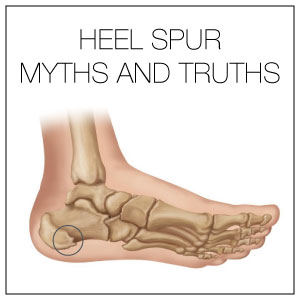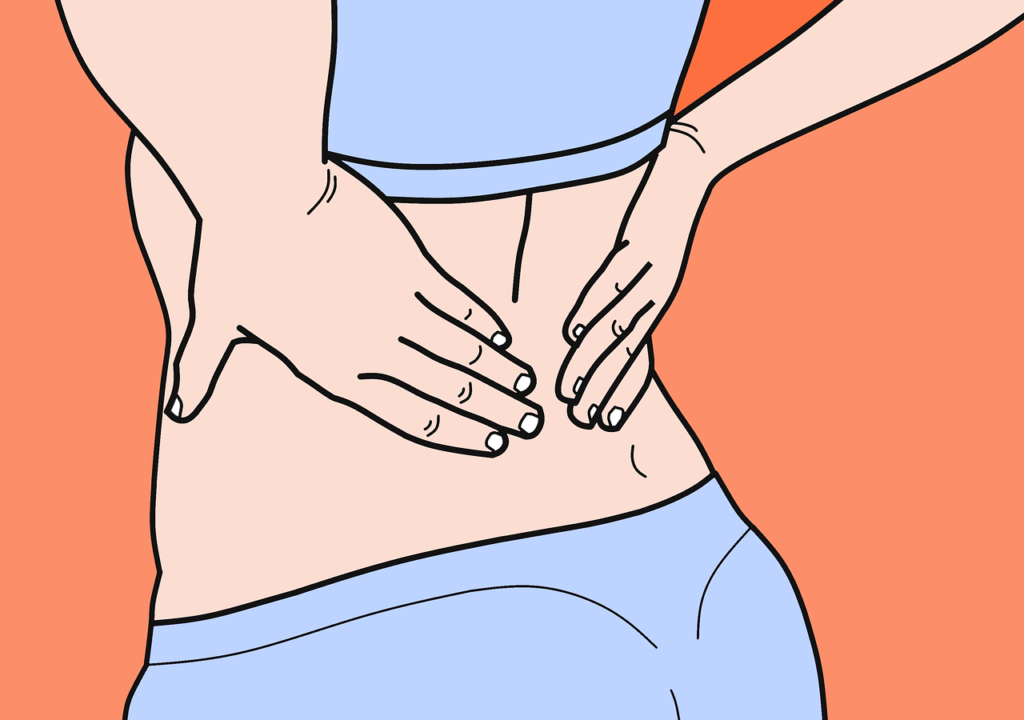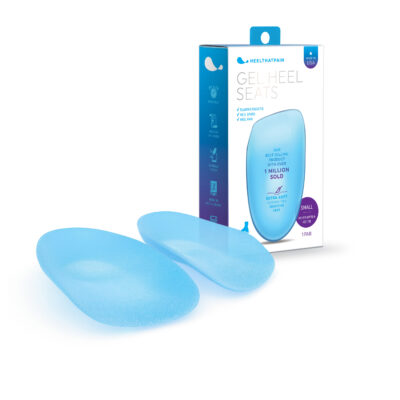 There’s a lot of mystery and misinformation out there about heel spurs.
There’s a lot of mystery and misinformation out there about heel spurs.
The x-ray photos of tiny white shark-fins protruding into the fatty pad of the heel, combined with the idea of a pointy, painful growth suddenly appearing is more than a little alarming, and foot folklore abounds when it comes to what heel spurs are capable of–and how they can be banished.
So, what’s the true story of these stealthy, sharp intruders?
In this post, we’ll separate fact from fiction and explore some of the most common truths and myths about heel spurs. After all, when you know the real truth about heel spurs, you can take the right steps to treat them!
#1: Can Heel Spurs Break Off?
TRUE. While uncommon, heel spurs do break off now and then, separating from the heel bone and becoming embedded in the foot’s soft tissues. When this happens, you may notice “locking” of the foot when you walk, and additional pain and discomfort.
The best way to avoid breakage is to treat heel spurs as soon as they become apparent through pain, discomfort, and a sharp jabbing sensation in the heel, especially during the first few steps in the morning. Wearing Heel Seats, which raise the arch to a healthy position and take the pressure off heel spurs, can also minimize the chances of breakage.

#2: Can Heel Spurs Be Removed?

TRUE. While surgery is recommended only after conservative treatments have been unsuccessful after at least one year, heel spurs can be removed through surgical intervention.
Guided by a tiny camera, a surgeon can use precise instruments to cut away the bony fragment protruding into the fatty pad of the heel. Heel spur removal surgery is often accompanied by plantar fascia release surgery, which detaches part of the plantar fascia from the heel bone, relieving stress and pressure on the arch.
Even when it’s determined that surgery is the best option to treat heel spurs, it’s important to take preventative steps to keep the heel spurs from returning, by supporting the arch of the foot and providing proper cushioning and impact absorption through high-quality footwear.
#3: Can Heel Spurs Be Dissolved?
UNCLEAR: While you’ll find numerous blog posts and supplements that claim to dissolve heel spurs, there isn’t a lot of scientific research to back these claims. Some suggest that simple apple cider vinegar added to the diet will dissolve heel spurs. Others insist that a deficiency in K2 and D3 vitamins are a contributing cause to the development of bone spurs, and that supplementing with these vitamins will allow the body to naturally dissolve the spurs.
While these natural remedies are generally harmless (as long as you stay within the prescribed daily recommendations for any vitamin supplement), it’s also vital to continue proven treatments for heel spurs, such as icing, rest, stretches, and the use of orthotic shoe inserts.
#4: Can Heel Spurs Move Around?
MOSTLY FALSE. Heel spurs are the result of calcium deposits that cause bony protrusions to grow out of the heel bone. In general, they stay affixed to one spot, although multiple heel spurs may develop on one heel bone.
In rare cases, the heel spur may break off from the heel bone, becoming embedded in the soft tissue and causing additional pain.
#5: Can Heel Spurs Cause Back Pain or Hip Pain?

TRUE. While heel spurs won’t directly cause back or hip pain, they can contribute to and exacerbate it. Heel spurs, especially when left untreated, will cause your gait to change, as you attempt to avoid the pain from the sharp protrusions. Over time, this can lead to misalignment and strain to the hips and back.
#6: Can Heel Spurs Break Through the Skin?
MYTH. While the sharp, piercing pain from a heel spur can, indeed, feel as though the tiny protrusion is trying to break through the skin, heel spurs cannot break through the skin.
When calcaneal heel spurs become very large, it may be possible to feel them beneath the skin; However, there’s no need to fear that the bony protrusion will actually break through the skin.
#7: Can Heel Spurs Make Your Feet Go Numb?
FALSE. As a general rule, heel spurs and plantar fasciitis will cause swelling, redness, and sharp, stabbing pains–but not numbness. If you’re experiencing numbness in one or both feet, Tarsal Tunnel syndrome is a more likely culprit.
Often confused for plantar fasciitis or heel spurs, Tarsal Tunnel syndrome is a result of compression of the tibial nerve and causes numbness and a “pins and needles” sensation, rather than sharp, stabbing pain.
The Truth About Preventing Heel Spurs
Now that you know the truth about heel spurs, you can take effective steps to prevent and treat them. The best way to avoid the development of new heel spurs or damage and pain from existing footwear is to support the arch of your foot properly. After all, a lack of arch support is one of the most common causes heel spurs develop in the first place!
Wear shoes that fit properly and give your heels and arches adequate cushioning and support. Add orthotic inserts to provide an additional boost in support and lift your arch to the optimal height, keeping heel spurs at bay and relieving pain from existing spurs.
It’s also important to maintain a healthy weight and rest your feet often when you’re required to stand for long periods of time.
Think of heel spurs as your foot’s prickly response to an overworked, over-strained arch. By taking care of that arch properly, most cases of heel spurs can be resolved with minimal mystery!




My question is can a heel spur go away on its own? I have had two cortisone shots with this knot really work for me the painted go away but then once the shot wore off it came back I have since bought really good expensive sneakers with dr. Scholl’s inserts is this necessarily mean my heel spur has gone away it still hurts if I walk barefoot in my house or even dare to wear flip-flops
Yes with stretch exercises it will go away and the proper shoe, my doctor told me to get inserts and new balance number 993 shoe, and with a little paticience and stretch routine it will. By the way my doctor told me absolutely no flip flops or barefoot
Good luck 🍀
Michaela, would you mind sharing what stretches worked for you? Thanks!
My husband had confirmed heel spurs over 10yrs ago. He started rolling his foot on a vegetable or soup can for 15-30 sec. before his feet touched the floor N the AM or after sitting for a spell. He got some reall good work boots. Before long his spurs were gone. Hasn’t had any pain for years now.
True heel spurs do NOT go away on their own. Surgery is required if they are that significant.
a heel spur broke off,, does the spur need to be removed?
Apparently I have a heel spur that is broken off and the doctor told me this morning that I needed to have surgery for it.
I shattered a heel spur the other day , going to ortho tomorrow and praying surgery isn’t needed . What was your outcome ?
How did your surgery go. Are you better now?
Hi April Erickson did you had the operation.
I just pray it goes away I broke my left foot and that is when I realized that I had a heel spur on the right it hurts way more than my broke foot
I read you blog throughly and I am really you for sharing such a meaningful facts about Heel Spur. The blog which you have shared will helpful for many people who are suffering from Heel Spur and doesn’t know the real cause and its prevention. Do share such type of blog for betterment. Keep Posting!!
I have had two injections in my heel. The pain is still horrible and the doctor suggesting that I have surgery. Should I have surgery or wait and see if it goes away? I have not been going on my daily walk because of my heel Should I be walking every day To help get rid of it?
True heel spurs do not go away on their own. Just had my second surgery only today after months and months of suffering.
Hi,
How long it’s take to recovery after surgery?
Never thought I would have a heel spur but it feels like it’s heel I pray The Lord Jesus Christ takes it or helps me deal with it God bless you all I pray any of you have to deal with it Amen
I have had lots of pain in my heel. Thought it was plantar fasciitis, i got orthotics for my shoes, and taped but would still be in pain although not as bad. This evening i went swimming with the grandchildren came home bare foot stepped wrong on a rock in the driveway, it was excruciating pain butt then it went away and now i have no pain at all. Could i have broken a heel spur loose?
I was swimming in the lake with my granddaughter when I stepped on a rock and broke my heel spur. I cried like a baby on her shoulder and she had to help me to the car. I couldn’t put any weight on it. The podiatrist has me wearing a knee high air walker cam boot for several weeks. It still hurts, but nowhere near the initial pain. OUCH!!
I went to the podiatrist this morning. He told me that there are 5 things that you can do for plantar fasciitis before the option of surgery. I also have heel spurs. (Sounds like they can go hand in hand.) Here are the 5 things 1) Never, EVER go barefoot. Get quality support for shoes in the house. 2) Meds…an anti-inflammatory 3) stretches 4) Inserts (NOT Dr. Scholl’s. He recommended Powerstep #L3040 and, 5) Cortisone shot (Hurts horribly…I thought I was tough) It can also intensify the pain for up to 72 hours) Yikes! Hope this helps
I had a heel spur years ago and my chiropractor fitted me with molded orthotics and then away at one and never returned! I still have them and wear them on a regular basis. I also wear flip flops
The shot is nothing in comparison to the continued pain from a heel spur. Y
just lied about pain to my podiatrist didnt want injections im such a wus wearing newbalance with higher end inserts and stretching no pain meds have smoked some meds lol but not much pain relief from it maybe less gripy seems like it will never end
I think I should take the shot it will be worth it I understand U smoke but I got this three tubes it. In s u up the pain u gonna b sore but the shot last up 3months
Hi,I was having excruciating pain in my heel along with leg cramping…do Not like going to doctors,all they want to do is give You medication or recommend surgery…I prefer natural remedies and will only go to the doctor as a very last resort So I went to a foot reflexologist and they took care of my heel spurs, I had two in my right heel and some crystals forming in my left…Told me my uric acid level in my body was very high and I also needed to do a colon cleanse …They can tell you everything about your body just from all the pressure points on your feet… recommended some products which I Purchased and am currently using. Still a little soreness in my foot from where they massaged it to break the spurs but feels 90% better
Hi would you mind sharing where you went for this? I’m currently experiencing daily pain on my heels and my doctor told me i have heel spurs after having x-rays done
My podiatist just told,me that I have broken off a bone spur and it is lodged in my Achilles tendon. Has anyone hear of this. He says surgery is needed.
I have a broken off posterior heel spur that’s causing me pain daily. I developed this after having plantar fasciitis for over a year. I did everything to treat it. Ice, heat, low dye taping, stretching, new shoes (10 pair to date), numerous insoles, compression socks, tennis balls, frozen bottles of ice, massage ect. I ended up getting cortisone injections to both heels. This helped for 3 months but the left foot developed a spur on the backside of the heel. Once the med wore off the pain came back differently. I no longer suffer from PF pain but I have the posterior heel pain from the Achilles spur. Wearing air boot now. Off to a specialist tomorrow for answers.
Chipped/fractured dorsal bone spur by Achilles last Saturday and podiatrist has me in a Cam walker boot . I felt a sharp jagged pain four times during the week and it was when I was barefoot in my apartment. I no longer go barefoot except when time for shower and bed. My follow-up appointment is on Monday July 29th. I am trying to stay positive but I am internally freaking out.
I have been told by my foot Surgeon That there are other options before surgery for heel spurs. Low dose radiation Therapy, Injections of platelets (Not steroids), Shock therapy from Podiatrist. The low dose radiation and shock therapy were recommended before Surgery.
I had heel spurs 16 years ago. Had the awful cortisone shots, was also fitted with special prosthesis nothing worked. I even did the recommended exercises.
One day I saw a doctor wearing interesting looking sneakers. They had a spring as a heel. I imagined how this spring in the heel can decrease the pressure that I have on my heel spurs.
Sure enough as soon as I tried them in the store I cried cause my pain was gone!!!
2 other friends bought them too and sure enough we all got cured in 3 to 6 months.
The magical shoes: zcoils!
Can u please let me know what type of sneakers r they I m really in pain
Good reading Hope some of these solutions help me.